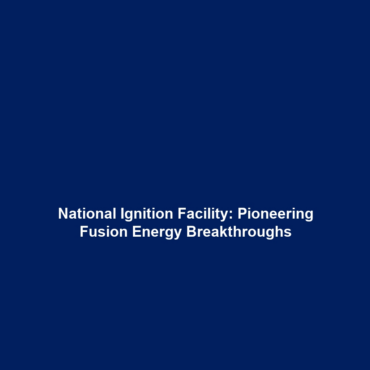Recent Progress: NIF Has Come Close to Achieving Ignition
Introduction
Recent advancements in laser-based fusion energy at the National Ignition Facility (NIF) represent a significant leap forward in the quest for sustainable energy solutions. Achieving ignition—where the energy produced by fusion reactions exceeds the energy input—has long been the Holy Grail for scientists and researchers in the field of Fusion Energy. As the NIF approaches this landmark achievement, it ignites hope for revolutionary breakthroughs that could redefine our approach to clean and abundant energy sources.
Key Concepts
Understanding Fusion Energy
Fusion energy is derived from the process that powers the sun, where atomic nuclei combine to form heavier elements, releasing immense amounts of energy. The NIF employs powerful lasers to create the extreme conditions necessary for this reaction. Key principles include:
- Inertial Confinement Fusion (ICF): Utilizes laser beams to compress and heat a small pellet of fuel to trigger fusion.
- Ignition: The point at which the fusion reaction becomes self-sustaining, greatly enhancing energy output.
- Energy Density: The goal of fusion is to achieve a high energy density, allowing for more efficient energy production.
Applications and Real-World Uses
The potential applications of recent progress in achieving ignition at the NIF extend beyond energy generation:
- Power Generation: Harnessing fusion could lead to cleaner and more sustainable power plants.
- Medical Applications: Developing advanced diagnostic and treatment techniques utilizing fusion technology.
- Space Exploration: Innovative propulsion systems for spacecraft powered by fusion energy.
Current Challenges
Despite promising advancements, several challenges persist in the study and application of laser-based fusion energy:
- High cost and complexity of fusion reactors.
- Need for significant technological advancements to achieve ignition.
- Sustainability of fusion reactions in practical applications.
Future Research and Innovations
The future of fusion energy hinges on continued research and innovation. Key areas of focus include:
- Next-Generation Facilities: Developing more advanced facilities that can optimize the ignition process.
- Hybrid Systems: Exploring systems that combine fusion with other renewable energy sources.
- Enhanced Laser Technologies: Innovations to improve the efficiency and effectiveness of fusion reactions.
Conclusion
In conclusion, recent progress at the National Ignition Facility marks a pivotal moment for the field of Fusion Energy, as scientists inch closer to achieving ignition. The implications of this achievement are profound, offering the potential for a new era of clean energy solutions. As research continues, stakeholders are encouraged to support efforts in this vital area. For more information on related topics, explore our articles on fusion research developments and sustainable energy technologies.

